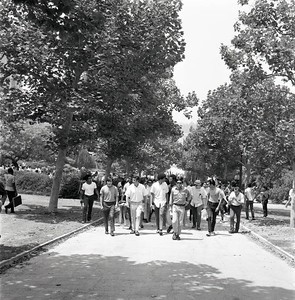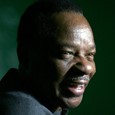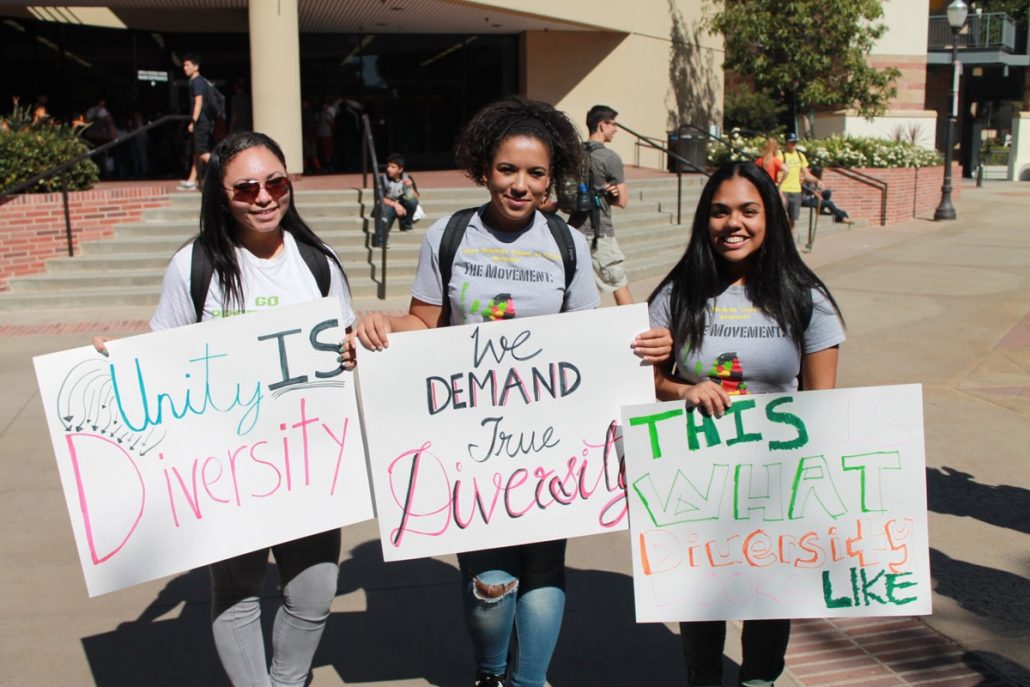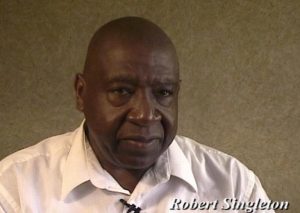Center Talk Editorial: Honoring the Past-Reinventing the Future
 Honoring the Past-Reinventing the Future
Honoring the Past-Reinventing the Future
By Lisbeth Gant-Britton
October 5, 2015 –Today, we once more find ourselves in a world where blood is being shed on college campuses. This is not the only time in history when this was so, particularly when it comes to black students. Back in 1969, right here on UCLA’s campus, the blood of two promising youth was spilled, right at the start of what would eventually become our very own Ralph J. Bunche Center for African American Studies. As we prepare to attend the Center’s annual Black Convocation (“Black Bruins Matter”) at UCLA on Tuesday October 6, 2015 in Haines Hall, it is only fitting that we take a moment to pay tribute to those twentieth century pioneers of Black progress who shed their blood to make it possible for us to be here today and to reflect on the all-too-many black youth shedding their blood today.
The date was Jan. 17, 1969. The place was UCLA’s Campbell Hall. The event was a tense meeting among youthful black college students. The place was Room 1201, now a tutoring center and classroom but then a small student dining hall. The reason for the meeting: debate regarding development of the country’s second black studies program and a new black research center on the UCLA Campus, including a decision about its possible new director. The shooting victims were two young Black Panther Party members, 23-year old John J. Huggins and 26-year old Alprentice “Bunchy” Carter. Along with Black Panther Party members Geronimo Pratt and Elaine Brown, they had been admitted in 1968 to what was then called UCLA’s High Potential Program, now known as the Academic Advancement Program (AAP). Carter had started the southern California branch of the Panthers.[1]
 Campus Historical – www.uclaphotography.com
Campus Historical – www.uclaphotography.com
UCLA Historical – August 8th, 1969, Coalition Campbell Hall Rally, UCLA, Los Angeles[2]
Previously, in 1967, students at San Francisco State University had succeeded in forcing their administration to undertake the first formal university black studies program in the country. And UCLA students had also jumped into the political and educational fray. But it was an issue fraught with many kinds of tensions. Not the least of which were ideological divisions between two of the most active groups of politically conscious black youth at the time, the Black Panther Party and US. The first was created in Oakland, California by Huey P. Newton and others to protect their community against police incursions and to promote neighborhood political cohesion and power. The second group, more African-centered, called US, headquartered in southern California, has traditionally been more involved in black cultural nationalism, including founding the Afrocentric holiday Kwanzaa.
How and why did the shooting occur? UCLA alumnus, J. Daniel “Skip” Johnson, a family therapist who chaired the meeting, was one of the few people who actually saw the ill-fated shooting take place. At a rally to commemorate the event, Johnson explained that as students were leaving the meeting, a fight broke out between 19-year old Harold “Tuwala” Jones, who entered the room late, and John Huggins. According to Johnson, while Huggins was arguing with Jones about a previous incident with Elaine Brown, yet another young black man joined in the fracas, “21-year-old Claude “Chuchessa” Hubert.” Johnson continued: “After a scuffle between John and Tuwala, Chuchessa shot John in the back. Then Bunchy tried to take cover behind a chair and Chuchessa shot through the chair and killed him instantly.” According to a Los Angeles Times report, Johnson speculated that “the U.S. government was in some way involved in the supposed escape by Hubert and Jones to Guyana, where they subsequently dropped from sight.” He said: “Very strong forces allowed them to get out of the country.” [3]
Even today, scholars are researching proven and possible U.S. government involvement in attacks on the Black Panthers through programs such as the infamous COINTELPRO Program, led by then FBI director J. Edgar Hoover.
As noted on the PBS website about the documentary A Huey P. Newtown Story: “According to FBI documents, one of the purposes of the COINTELPRO program was to ‘expose, disrupt, misdirect, discredit, or otherwise neutralize the activities of the Black nationalists’. They wanted to prevent the rise of a black “messiah” and Martin Luther King Jr. had been amongst the candidates until his assassination in 1968 when the attention shifted to Huey P. Newton. Of the 295 documented actions taken by COINTELPRO to disrupt Black groups, 233 were directed against the Black Panther Party.”[4]
Since that difficult time, 1969 saw the inception of UCLA’s Center for Afro American Studies. Professor Molefi Asante directed the Center from 1969 to 1973. In 1969 he was the co-founder with Professor Robert Singleton of the Journal of Black Studies. An Afrocentric scholar, Asante then went on to become Professor and Chair of the Department of African American Studies at Temple University.

Professor Molefi Asante –http://www.asante.net/biography/[5]
Dr. Singleton was one of the Civil Rights Movement’s original Freedom Riders. He is now a professor of Economics at Loyola Marymount University. http://myweb.lmu.edu/rsingleton/[6]
Since renamed the Ralph J. Bunche Center for African American Studies, the hard-working organization is now helmed by Dr. Darnell Hunt, currently also serving as chair of the UCLA Sociology Department.
Dr. Darnell Hunt, Bunche Director/Chair of the UCLA Sociology Department.http://www.sociology.ucla.edu/faculty/darnell-hunt[7]
Later, UCLA added its Afro-American Studies Program, which became a full department in 2014. During recent years, students have pushed for more diversity throughout the campus.

UCLA Students Protest the Naming of Carnesale Commons | NOMMOPhotojournalist: Mark Anderson/ Nommo Staff[8]
The Ralph J. Bunche Center’s Black Convocation “Black Bruins Matter” will bring together community members, students, faculty, and interested others to discuss, among other items, how African American and ethnic studies is developing on the UCLA campus and to commemorate the numerous critically important research projects undertaken by the Center, including one of its most recent Race and Hollywood report. We encourage you to join us at the Black Convocation to make your voice heard regarding the continuing need for diversity at UCLA and on all college campuses, as one way to encourage dialogue and mutual understanding rather than firearms and frightening episodes of bloodshed for our precious students. For more information on the Black Convocation, Click Here.
[1] Another Side of the Sixties: Black Panthers at UCLA (Posted: 05/25/2010 5:29 pm EDT Updated: 05/25/2011)
http://www.huffingtonpost.com/devon-mcreynolds/another-side-of-the-sixti_b_589322.html
[2] Campus Historical – uclaphotography
www.uclaphotography.com295 × 300Search by image
UCLA Historical – August 8th, 1969, Coalition Campbell Hall Rally, UCLA, Los Angeles
[3] Witness to 1969 UCLA shootings speaks at rally (January 18, 2008)
http://articles.latimes.com/2008/jan/18/local/me-panthers18
[4] A Huey P. Newton Story (Copyright 2002 Luna Ray Films, LLC)
http://www.pbs.org/hueypnewton/actions/actions_cointelpro.html
[5] http://www.asante.net/biography/
[6] http://myweb.lmu.edu/rsingleton/
[7] http://www.sociology.ucla.edu/faculty/darnell-hunt
[8] Recap: UCLA Students Protest the Naming of Carnesale Commons | NOMMO
nommomagazine.com1200 × 800Search by image
Photojournalist: Mark Anderson/ Nommo Staff https://www.google.com/search?q=ucla+nommo+campbell+hall+rally&rlz=1C1CAFB_enUS620US631&espv=2&biw=1081&bih=615&source=lnms&tbm=isch&sa=X&ved=0CAgQ_AUoA2oVChMI7oL95N-ryAIVCqWICh2I4gB5&dpr=1#imgrc=56dkoP-yujXHgM%3A



